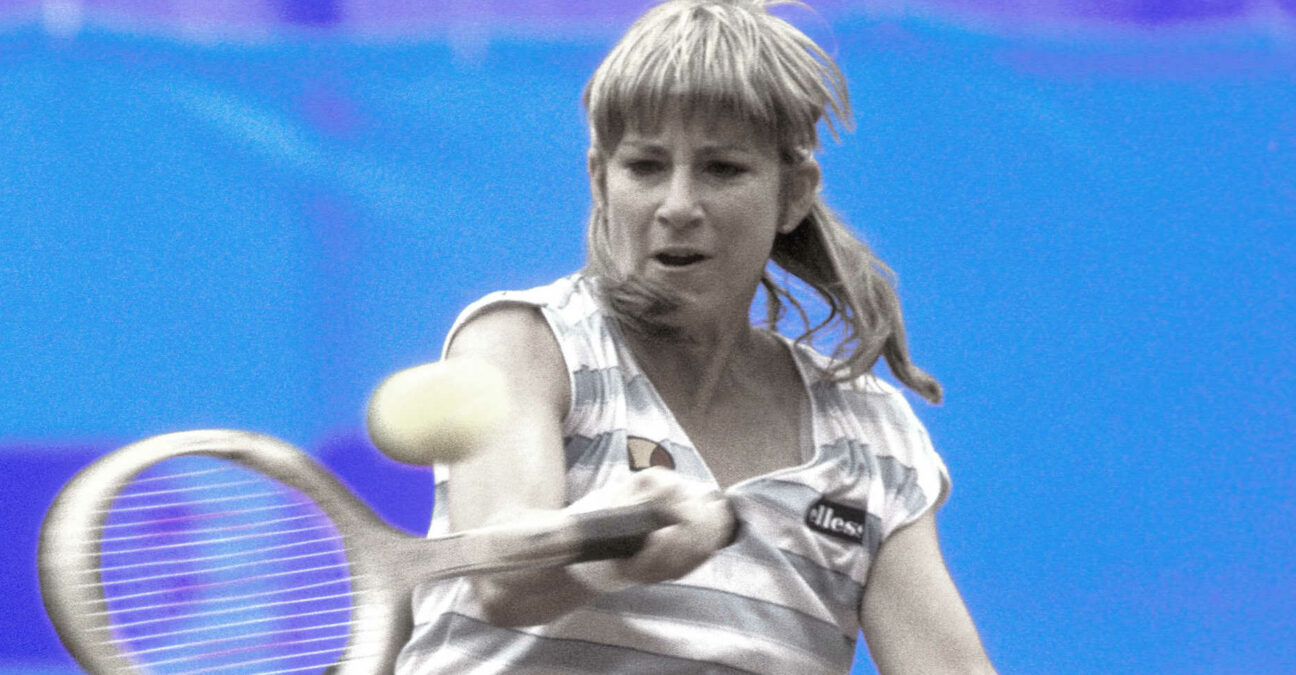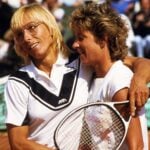December 5, 1982: The day Chris Evert won the Australian Open to complete the career Grand Slam
Every day Tennis Majors looks back to the biggest moments in tennis history. On December 5, 1982, Chris Evert defeated her biggest rival, Martina Navratilova, to complete the full set of all four majors
 Chris Evert – Lloyd (USA) – Ball FILA Cup 1983 – 10.05.1983 – Tennis – Femme femmes – largeur action 00713408
Chris Evert – Lloyd (USA) – Ball FILA Cup 1983 – 10.05.1983 – Tennis – Femme femmes – largeur action 00713408
What exactly happened on that day
On this day, December 5, 1982, Chris Evert won the Australian Open title for the first time, defeating world No 1 Martina Navratilova, in the final (6-3, 2-6, 6-3). Evert, who had been the most dominant player on the Tour between 1974 and 1980, was only attending the event for the third time in her career, having finished runner-up in 1974 and 1981.
The players: Chris Evert and Martina Navratilova
- Chris Evert: Ice cool, the best baseliner of all time
Chris Evert was born in 1954 in Florida. Coached by her father, she developed a game based on consistency, keeping her opponents away from the net with her deep groundstrokes, and punishing them with great passing shots if they were to take the net carelessly.
She obtained her first remarkable result at the age of 16, reaching the semi-final at the US Open (defeated by world No 1, Billie Jean King, 6-3, 6-2). In 1973, at the age of 18, she finished runner-up at both Roland-Garros and Wimbledon, beaten by the two best players in the world, King and Margaret Court. In 1974, Evert eventually claimed her first and second Grand Slam titles, prevailing against Olga Morozova in both Roland-Garros and Wimbledon finals. She finished the year as world No 2, winning no less than 16 tournaments, and also gained media exposure by starting a romance with American superstar Jimmy Connors.
In 1975, Evert continued her winning streak on clay, triumphing at the French Open for the second time, defeating her future biggest rival in the final, Martina Navratilova (2-6, 6-2, 6-1), and she also won the US Open, who was played on clay for the first time (defeating Evonne Goolagong in the final, 7-5, 4-6, 6-2). She became the first world No 1 of the newly established WTA rankings, and she held that spot without interruption until 1979.
By 1981, although her dominance was challenged by Navratilova and Tracy Austin, she had accumulated 11 Grand Slam titles and reached the final of every major tournament she attended since her semi-final loss at Wimbledon, in 1975. She was almost unbeatable on clay, and she she completed a winning streak of 125 matches on red dirt, between 1973 and 1979. However, all through 1981 and 1982, she saw Navratilova taking a hold on the Tour and, although she added a 12th major title to her list of achievements at the 1982 US Open, Evert lost the world No 1 spot in June.
- Martina Navratilova: Left-handed, serve and volley genius
In 1982, Martina Navratilova, born in 1956, seemed to have taken the edge over her old-time rival, Chris Evert. The Czech had turned pro in 1975, reaching the finals at both the Australian Open (defeated by Evonne Goolagong, 6-3, 6-2) and Roland-Garros (lost to Evert, 2-6, 6-2, 6-1). In the following years, she established herself in the top 4, winning 22 tournaments, but it was not before 1978 that she finally claimed her first major title at Wimbledon (defeating Evert in the final, 2-6, 6-4, 7-5). Shortly after, Navratilova became world No 1 for the first time, but at the US Open, she was eliminated in the semi-finals by 16-year-old Pam Shriver (7-6, 7-6).
The following year, she defended her title at the All England Club (defeating Evert, 6-4, 6-4), but at the US Open, she was once again stopped in the semi-final round by a young rival, Tracy Austin (7-5, 7-5). In 1980, she won 11 tournaments on the Tour, but her Grand Slam results were disappointing, and she finished the year as world No 3, behind Evert and Austin.
At the time, she was in the process of becoming an American citizen, and she was also criticised for her lack of fitness and her affinity for fast foods. In early 1981, a cruel loss against Evert (6-0, 6-0) was the wake-up call she needed to fully commit to her career. She won five of the six following encounters with her rival and claimed three Grand Slam titles in less than12 months to become the undisputed world No 1 in June 1982.
The place: Kooyong Stadium, Melbourne
Unlike the other Grand Slam tournaments, The Australian Open (first known as the Australiasian Championships and, later, the Australian Championships) had moved several locations throughout the years. In fact, the event switched cities every year before it settled in Melbourne in 1972, and no fewer than five Australian cities had hosted the event at least three times : Melbourne, Sydney, Adelaide, Brisbane and Perth.
The event was held on grass at the Kooyong Stadium, in a posh eastern suburb of Melbourne. Its timing had changed several times as well, between early December and January, going from being the first Grand Slam of the year to being the last. Until 1982, many of the best players skipped the Australian Open, because of the remoteness, the inconvenient dates (around Christmas and New Year’s Day) and the low prize money.
The facts: Evert hammers Navratilova back with pin-point accuracy
In December 1982, although Chris Evert still led 29-18 in her head-to-head against Martina Navratilova, she was far from being the obvious favourite when the two women faced each other once again in the Australian Open final.
Since Evert had destroyed Navratilova 6-0, 6-0 in Amelia Island, in April 1981, her rival had become a totally different player. The gifted but sometimes unfit lefty had taken her fitness to a new level, and since that double bagel, Navratilova had prevailed in five of their six encounters. On top of that, Navratilova, who sat at the top of the WTA rankings since June 1982, had defeated Evert in two Grand Slam finals on grass, at the 1981 Australian Open (6-7, 6-4, 7-5), and at Wimbledon in 1982 (6-1, 3-6, 6-2).
Having met her rival 37 times already, Evert knew that if she wanted to stand a chance on grass, she needed to play as deep as possible to keep her at bay and to display great precision at passing shots. She did that perfectly in the first set, which she won 6-3, but in the second set, Navratilova increased her level and outplayed Evert, 6-2. However, in the deciding set, “Chrissie” quickly took the lead, 5-1, and, despite a little scare when her opponent came back to 5-3, she sealed her first Australian Open triumph, 6-3, 2-6, 6-2.
For Evert, this 113th Grand Slam title had a special meaning. First of all, she joined the small group of players to have won all four major titles in their career, along with Maureen Connolly, Doris Hart, Shirley Fry, Margaret Court and Billie Jean King, who had been the last player to achieve that feat, in 1973. Moreover, she reminded the tennis world that, despite Navratilova’s hold on the Tour and their rivalry in the past 18 months, she was still a contender for big titles and for the world No 1 spot.
What next: Evert wins more slams, Navratilova dominates
In 1983, Evert would claim a third consecutive Grand Slam title, defeating Mima Jausovec in the Roland-Garros final (6-1, 6-2). She would recover the world No 1 spot for 20 weeks only in 1985. At the end of her career, in 1989, she would hold 18 Grand Slam titles, having spent 260 weeks as world No 1.
Navratilova would dominate the game until the raise of Steffi Graf, in 1987, setting a record of 332 weeks as world No 1 (a record beaten by Graf in 1996). In total, Navratilova would accumulate 18 Grand Slam crowns at singles, but also 31 at doubles and 10 at mixed doubles.
The two women would face each other for the 80th and final time in 1988, in Chicago, and Navratilova would then lead 43-37 in their head-to-head.
















